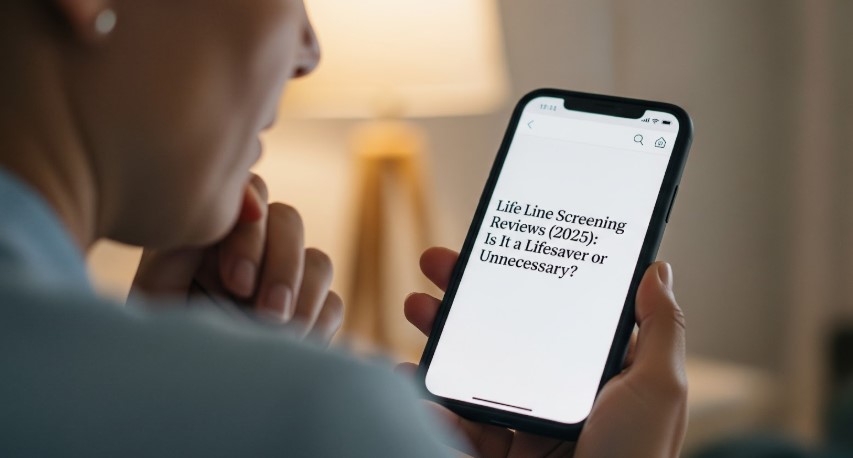The advertisement often arrives as a letter in your mailbox, a flyer at your local community center, or an ad on social media. It speaks in the urgent, compelling language of prevention: “Prevent a Stroke,” “$159 Could Save Your Life,” “Peace of Mind.” The company is Life Line Screening, and their promise is powerful: for a low, out-of-pocket cost, they can screen you for some of the most feared silent killers—strokes, aortic aneurysms, and vascular disease.
For millions of Americans, particularly those over 50, this offer is incredibly alluring. It feels proactive, empowering, and like a sensible way to take control of one’s health. The convenience of having these tests done in a local church or community hall, without needing a doctor’s referral or dealing with insurance, has made Life Line Screening a massive commercial success.
But within the medical community, this direct-to-consumer mass screening model is the subject of a fierce and long-standing debate. On one side is the argument for early detection. On the other are the significant, well-documented dangers of over-screening. Does Life Line Screening save lives by finding problems early, or does it generate unnecessary anxiety, false positives, and costly, sometimes risky, follow-up procedures?
This comprehensive, 3000+ word guide will provide a balanced, in-depth analysis of Life Line Screening. We will explore the services they offer, summarize the spectrum of customer reviews, and, most importantly, examine the evidence-based guidelines from major medical organizations to help you make an informed decision in partnership with your doctor.
What is Life Line Screening and What Do They Test For?
Life Line Screening is a private, for-profit company that operates a mobile health screening service. Their business model is to travel across the country, setting up temporary screening clinics in non-medical community settings. They offer a menu of tests, often bundled into packages, that are designed to detect risk factors for specific cardiovascular and other age-related conditions.
Their technicians use non-invasive equipment, like ultrasound wands and blood pressure cuffs, to perform the screenings. The results are then reviewed by board-certified physicians and mailed to the customer within a few weeks. It’s crucial to understand that they do not diagnose disease; they provide risk assessments and recommend you share the results with your doctor.
Let’s break down their core screening package:
1. Carotid Artery (Plaque) Screening
- What It Is: A technician uses an ultrasound wand on your neck to create an image of your carotid arteries, the main vessels supplying blood to your brain.
- What It Looks For: They are looking for plaque buildup (atherosclerosis) that can narrow the arteries. Significant narrowing, known as carotid artery stenosis, is a major risk factor for stroke.
2. Abdominal Aortic Aneurysm (AAA) Screening
- What It Is: An ultrasound of your abdomen to measure the width of your aorta, the largest artery in your body.
- What It Looks For: They are searching for an Abdominal Aortic Aneurysm (AAA), which is a weak, bulging spot in the artery wall. A large aneurysm can rupture, which is a catastrophic and often fatal medical emergency.
3. Peripheral Arterial Disease (PAD) Screening
- What It Is: This is a simple test where they use blood pressure cuffs to measure the blood pressure at your ankles and in your arms. The ratio of these two numbers is called the Ankle-Brachial Index (ABI).
- What It Looks For: A low ABI score indicates that you may have plaque buildup in the arteries of your legs and feet, a condition known as Peripheral Arterial Disease (PAD). PAD is a strong indicator of broader cardiovascular disease.
4. Atrial Fibrillation (AFib) Screening
- What It Is: A 6-lead electrocardiogram (ECG) that records the electrical activity of your heart for a brief period.
- What It Looks For: This test is designed to detect Atrial Fibrillation (AFib), an irregular and often rapid heart rhythm. AFib can lead to blood clots, stroke, and other heart-related complications.
5. Osteoporosis Risk Assessment
- What It Is: An ultrasound of the shin bone to measure bone density.
- What It Looks For: This is a screening for low bone mass, which is a risk factor for osteoporosis and fractures. It’s important to note this is not the same as a clinical DEXA scan, which is the gold standard for diagnosing osteoporosis.
The Customer Experience: A Summary of User Reviews
Online reviews for Life Line Screening paint a picture of two very different experiences, often dependent on the customer’s expectations and the results they receive.
The Positive Reviews: “Peace of Mind” and “Convenience is Key”
The vast majority of customers have a smooth and positive experience with the screening process itself, and their reviews often highlight several key themes:
- Convenience and Accessibility: Users consistently praise how easy it is to book an appointment and attend a screening. The local, community-based settings are far less intimidating and time-consuming than navigating a hospital or imaging center.
- Professional and Friendly Staff: Most reviewers describe the technicians as professional, kind, and efficient. They make the process comfortable and explain each step clearly.
- Affordability and Transparency: The package pricing is clear and, for those without good insurance or with high deductibles, can seem very affordable compared to the potential cost of getting these tests through a traditional healthcare provider.
- A Feeling of Proactive Empowerment: Many customers walk away with a profound sense of “peace of mind.” They feel they have taken a responsible, proactive step in managing their health, and for the 95%+ of people who receive normal results, this is a very reassuring experience.
- The Legitimate “Catch”: It is important to acknowledge that in some cases, Life Line Screening does find legitimate, asymptomatic, and serious medical issues. There are many testimonials online from people who were alerted to a large AAA or a severe carotid blockage, took the results to their doctor, and received life-saving surgery. For these individuals, the screening was invaluable.
The Negative Reviews and Criticisms: “Anxiety-Inducing” and “Sales Pressure”
The negative experiences often have less to do with the screening itself and more to do with the sales tactics and the aftermath of receiving an abnormal or unclear result.
- High-Pressure Sales Tactics: A very common complaint is the persistent upselling. After signing up for the basic package, many customers report receiving phone calls encouraging them to add on more tests, such as blood tests for cholesterol or diabetes, for an additional cost. The technicians on-site may also try to sell additional screenings.
- Anxiety from Vague Results: When a result is “borderline” or shows a minor, non-critical issue, it can cause immense anxiety. The results are mailed with limited context, leaving the customer to worry for days or weeks until they can see their own doctor, who may or may not be concerned.
- The Stress of a False Positive: As we will explore later, these tests can produce “false positives”—a result that suggests a problem exists when it actually doesn’t. This can trigger a cascade of unnecessary, expensive, and sometimes risky follow-up tests and a huge amount of psychological distress, only to find out that nothing was wrong in the first place.
- Difficulty with Physician Follow-Up: Some users report that their primary care doctors are dismissive of the results from a direct-to-consumer screening company, preferring to re-order the tests through their own trusted hospital or imaging center.
The Medical Community’s Perspective: The Crucial Debate
This is the most critical part of the entire discussion. While the idea of “the more information, the better” seems logical, the mainstream medical community, including most major medical societies and government-backed task forces, has a much more nuanced and cautious view. The core of the debate is Targeted Screening vs. Mass Screening.
Targeted Screening vs. Mass Screening: The Core Issue
Your primary care doctor practices targeted screening. They act as a filter. Based on your specific age, gender, family history, lifestyle (especially smoking history), and existing health conditions, they decide which tests have a high probability of benefiting you. For example, they won’t order a prostate cancer screening for a 25-year-old woman because it makes no sense. This is a simple example, but the same logic applies to more complex conditions. This targeted approach maximizes the chance of finding real disease while minimizing the harm from unnecessary testing.
Life Line Screening practices mass screening. They offer the same battery of tests to large groups of self-selected, generally healthy people who see their ads. This approach casts a very wide net. While it might catch a few fish, it also drags in a lot of “dolphins”—false positives and insignificant findings that cause more harm than good.
What the U.S. Preventive Services Task Force (USPSTF) Recommends
The USPSTF is the leading independent panel of national experts in disease prevention. Their recommendations are considered the gold standard in American medicine because they are based on a rigorous review of all available scientific evidence. Here’s how their evidence-based recommendations stack up against Life Line Screening’s main tests:
- Abdominal Aortic Aneurysm (AAA): HIGHLY RECOMMENDED (for a specific group).
- USPSTF Guideline: Recommends a one-time ultrasound screening for AAA in men aged 65 to 75 who have ever smoked. They state there is insufficient evidence to screen men who have never smoked. They recommend against routine screening in women who have never smoked because the risk of harm outweighs the very low chance of finding a dangerous aneurysm.
- The Conflict: Life Line Screening markets this test to all adults, regardless of their specific risk factors.
- Carotid Artery Stenosis: EXPLICITLY RECOMMENDED AGAINST.
- USPSTF Guideline: This is the most important one. The USPSTF explicitly recommends against screening for carotid artery stenosis in the general, asymptomatic adult population.
- The Reason: The evidence shows that the potential for harm is significant. The ultrasound test has a high rate of false positives. A positive result could lead to a confirmatory angiogram (an invasive procedure with its own risks) and potentially a carotid endarterectomy (a major surgery with risks of heart attack, stroke, and death). The USPSTF concluded that for people without symptoms, the risks from this cascade of events are greater than the risk of the stroke the test is trying to prevent.
- Peripheral Arterial Disease (PAD): INSUFFICIENT EVIDENCE.
- USPSTF Guideline: The USPSTF concludes that the current evidence is insufficient to assess the balance of benefits and harms of screening for PAD in asymptomatic adults. They do not recommend for or against it.
The Dangers of Overscreening: False Positives and Incidentalomas
The core reason medical experts are wary of mass screening is the harm it can cause.
- False Positives: No test is perfect. A false positive occurs when a test indicates you have a condition, but you actually don’t. This can lead to a “cascade of care”—more doctor’s visits, more advanced (and expensive) imaging, and sometimes invasive procedures like biopsies or angiograms, all of which carry their own risks and costs, not to mention the immense anxiety and stress they cause.
- Incidentalomas: This is the medical term for things found by chance that you weren’t even looking for. An ultrasound of the abdomen for an AAA might reveal a harmless cyst on the kidney or a spot on the liver. While likely benign, it cannot be ignored. It now requires a follow-up, creating a new medical journey that may have been completely unnecessary.
The Best Alternative: Partnering with Your Primary Care Physician
The best approach to preventive health is not found in a community center but in an ongoing relationship with a primary care physician (PCP). Your doctor is your health partner and the best person to manage your preventive care for several reasons:
- They Know You: Your doctor understands your full medical history, your family history, your lifestyle, and your personal values.
- They Practice Evidence-Based Medicine: They follow guidelines like those from the USPSTF to determine which screenings are appropriate for you specifically.
- They Can Order the Right Tests: If you are a 68-year-old male smoker, your doctor will and should order an AAA screening for you.
- Insurance Covers Recommended Tests: When a screening is medically indicated and ordered by your doctor, it is almost always covered by your insurance.
- They Can Interpret the Results: If a result comes back abnormal, your doctor is there to provide immediate context, order the appropriate follow-up tests, and manage your care, preventing unnecessary panic.
Conclusion: A Tool with Significant Caveats
So, is Life Line Screening a lifesaver or an unnecessary service? The honest answer is that it can be both.
For the small number of people who are walking around with a ticking-time-bomb aneurysm and fall through the cracks of the traditional healthcare system, a Life Line screening could genuinely save their life. The convenience and affordability of the service are real benefits, and the experience for most customers is positive.
However, for the vast majority of the healthy, asymptomatic population they screen, the service is likely unnecessary. It runs contrary to the evidence-based guidelines established by the nation’s top medical experts. The potential harms—including the financial cost, the immense anxiety from false positives, and the risks of unnecessary follow-up procedures—are significant and often downplayed in their marketing.
The decision to get a medical screening should not be based on a mailer or a persuasive ad. It should be a thoughtful conversation between you and your doctor. Your physician can assess your personal risk profile and help you decide which preventive screenings make sense for you, when you should get them, and where you should have them done. That is the safest, most effective, and most truly “proactive” path to managing your long-term health.










